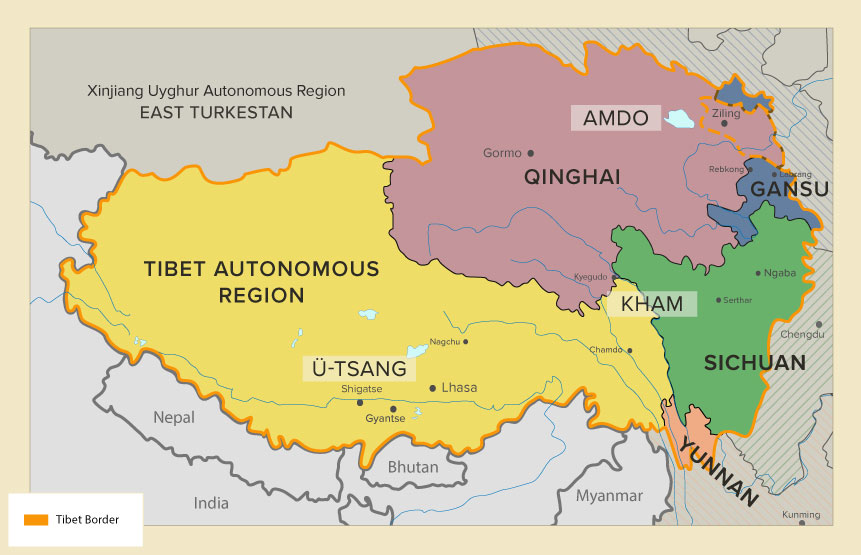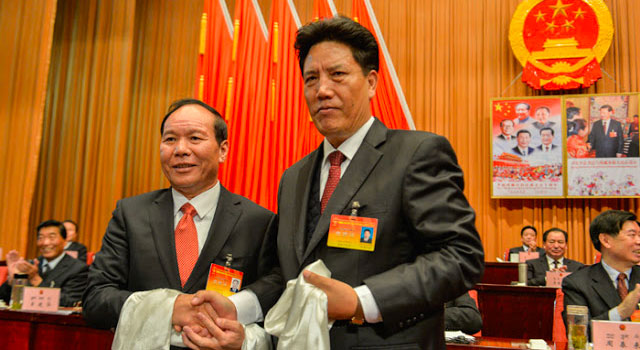It is no secret that a hallmark of the People’s Republic of China is trafficking in falsehoods thus fulfilling a primary pillar of totalitarian regimes—not the control of facts per se but the erasure of the distinction between truth and lies. This is a defining element of totalitarian regimes because every inch of a society must serve the leader’s ideology and the political utility of the moment.
A proven tool to achieving this phenomenon is repetition. Today, this is an increasingly effective and efficient methodology in a global environment of rapid media cycles, social media networks, and China’s enormous capacity and investment in controlling physical and digital information flow. A deep analysis of Beijing’s internal and external use of propaganda is both beyond the scope of this piece and unnecessary. Like so many truths, the reality of China’s actions are irrefutable: transnational harassment, and an unrelenting and blatant denial of the facts.
The case of Tibet
China has spent seven decades erecting a bulwark of propaganda to hide the truth of its occupation and crimes against humanity in Tibet.
Beijing’s relentless disinformation and only argument for its occupation is that Tibet has been part of China’s domain since “antiquity,” making its invasion under Mao Zedong in 1950 a “liberation.” Here we witness an assertion so easily punctured as to be laughable. In fact, Chinese records, legal analysis and archaeological evidence confirm Beijing’s claims are counterfactual.
More than anything, however, common sense belies any such statement. Simply put, if Tibet had been owned by China since antiquity, why was it necessary to inflict the wave of destruction following its takeover? If the motive was freedom, why did 1.2 million human beings lose their lives? Why were thousands of monasteries demolished and plundered? Why were book burnings prevalent, nuns raped and citizens disappeared?
Perhaps most significantly, why are 6 million Tibetans still suffering in an open-air prison while crimes against humanity are regularly inflicted on the society at large? It would seem genuine “liberation” and subsequent “benevolent” rule would not require these mounting excesses.
This brings us to what the United States can do now to confront Beijing’s attempts to rewrite history, condemn its brutality and codify that US support of Tibet will never waiver until the facts on the ground demonstrate the cessation of acts so gruesome as to approach genocidal, and genuine self-determination for the Tibetan people is reached.
A first step is to remember the oft-cited adage that insanity is doing the same thing, over and over again, but expecting different results. Currently, this seems to be the United States’ approach in a nutshell.
This is not to say that the United States is ignoring Tibet. That is not the case and should never be construed as such. The United States often has led the world in chastising China for its inhumane actions and led the way by passing its own important laws, including the Tibetan Policy and Support Act and the Reciprocal Access to Tibet Act.
That said, when it comes to countering Beijing’s long-term Tibet stratagem the United States must take the next logical step in bolstering its stance. Specifically, no longer allowing China to simply stonewall any attempt to cement a resolution by abandoning the negotiating table, as it did 13 years ago, leaving potential solutions on the cutting room floor.
We must recognize what China’s refusal to continue talks means. The PRC has telegraphed repeatedly that after the eventual passing of the current Dalai Lama, it intends to install a patently false, handpicked “Dalai Lama” it assumes it can control to serve its political agenda.
Certainly, such a possibility is as transparent as it is recognized. And through six presidential administrations, the United States has called upon China to resume dialogue with His Holiness the 14th Dalai Lama. Here we come to the crux of the matter and return to our famous adage.
China isn’t listening. It is time for the United States—and the global community—to respond accordingly. A starting point is busting China’s myth that “there is nothing to see here.” Which is what the Resolve Tibet Act is all about.
The Resolve Tibet Act
Introduced by Rep. Jim McGovern, D-Mass., and Foreign Affairs Committee Chairman Michael McCaul, R-Texas, in the House and Sens. Jeff Merkley, D-Ore., and Todd Young, R-Ind., in the Senate, the bipartisan Resolve Tibet Act strikes at the core of China’s Tibet strategy in five main ways.
First, it states in unambiguous terms that the situation in Tibet is not yet resolved. This is self-evident, as no agreement between Tibetan leadership and the Chinese government has been reached. This is irrefutable because if an agreement were in place, Tibetan leadership would acknowledge it since negotiating a peaceful solution has been His Holiness the Dalai Lama and the Central Tibetan Administration’s stated goal for decades.
We must recognize that China’s waiting game is keyed to the passing of the current Dalai Lama. To counteract this, the global community must make crystal clear its policy is to protect the institution of the Dalai Lama and Tibetans’ right to freely choose their religious leaders, no matter what the particular circumstances.
Second, allowing any ambiguity in the United States policy position and how it is relayed to the public risks, at least partially validating Beijing’s relentless assertions that whatever happens in Tibet is “an internal matter” and any criticism is due to “outside agitators.” Once again, we encounter the totalitarian regime’s need to control all aspects of society—no matter what level of denial it requires. In the case of Tibet, clarifying that the United States does not consider the Tibet crisis settled will only underscore that not only is China’s strategy in Tibet unjustifiable, but its actions also violate international law, which clearly states that crimes against humanity must be condemned and efforts made to halt them wherever they occur.
Third, the legislation defines Tibetans as a people deserving of the human right to self-determination. In truth, this policy provision should never have to be put forward. Without doubt, the Tibetans have shared a common history, language, culture, religion, language and DNA for several thousand years. It is hardly tenable, therefore, to make any assertion otherwise. And once again, international law and basic ethics provide that a people have the right to define their future, i.e. self-determination.
Fourth, the legislation provides a new means to counter China’s lies by mandating that the Special Coordinator for Tibetan Issues actively refute propaganda regarding Tibet and His Holiness the Dalai Lama. Considering the scale of China’s disinformation campaign and hypersensitivity to matters related to the Dalai Lama, this is yet another essential tool in combating Xi Jinping’s increasingly totalitarian methodologies.
Finally, the bill validates that Tibet’s boarders are defined by proven history, not the artificial carving up of an occupied sovereign state, a well-worn strategy of conquerors and colonialists to isolate communities and disrupt cultural continuity. Below is a map depicting historic Tibet and the segmentation imposed by China over the years. The conclusion is self-explanatory and reinforces the need to state clearly that the status of Tibet is far from resolved.

Conclusion
The point of this exercise is more than demonstrating the import and relevance of the Resolve Tibet Act to the future of Tibet, which is obvious. It also is a challenge to our elected leaders, from Congress to the administration to our international partners, to embrace the truth. Part of that is realizing that what is happening in Tibet is a microcosm of Xi Jinping’s totalitarian goals and transparent agenda to dismantle a world order based on democracy, human rights and free will.
Or in the words of author Chimamanda Ngozi Adichie, “Now is the time to counter lies with facts, repeatedly and unflaggingly, while also proclaiming the greater truths: of our equal humanity, of decency, of compassion. Every precious ideal must be reiterated, every obvious argument made, because an ugly idea left unchallenged begins to turn the color of normal. It does not have to be like this.”
In the end, it’s not very complex. The world must not permit the Xi Jinping regime to turn truth inside out. We cannot afford to imitate China’s cherry picking of what is and isn’t factual based on political expedience.
After all, the truth shouldn’t be so hard to say, should it?

